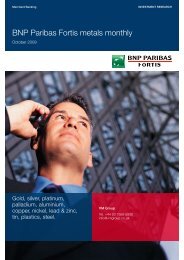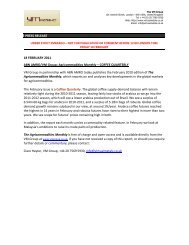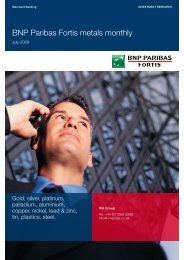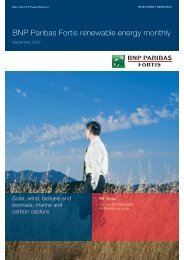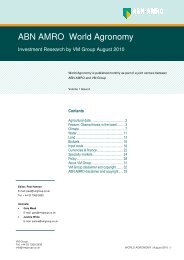BNP Paribas Fortis North American energy monthly - Virtual Metals
BNP Paribas Fortis North American energy monthly - Virtual Metals
BNP Paribas Fortis North American energy monthly - Virtual Metals
Create successful ePaper yourself
Turn your PDF publications into a flip-book with our unique Google optimized e-Paper software.
6 | <strong>BNP</strong> <strong>Paribas</strong> <strong>Fortis</strong> <strong>North</strong> <strong>American</strong> <strong>energy</strong> <strong>monthly</strong> | October 2009 <strong>BNP</strong> <strong>Paribas</strong> <strong>Fortis</strong>/VM Group<br />
and gas output. However in sidestepping the issue of possible deliberate underreporting<br />
Gerard is at risk of ignoring the new mood in Washington.<br />
Federal onshore royalty estimates<br />
FY 2009 FY 2010 FY 2011 FY 2012 FY 2013 FY 2014<br />
Oil volume (million barrels) 105 104 103 102 100 97<br />
Oil royalties ($m) 560 632 687 713 739 767<br />
Source: US Department of Interior/ Minerals Management Service<br />
Discrepancies in totals may occur due to rounding.<br />
Federal offshore royalty estimates<br />
FY 2008 FY 2009 FY 2010 FY 2011 FY 2012 FY 2013<br />
Oil volume (million barrels) 478 553 696 813 844 812<br />
Oil royalties ($m) 2,971 3,875 5,316 6,445 6,867 6,773<br />
Source: US Department of Interior/ Minerals Management Service<br />
Open to abuse<br />
Several times during recent years, the RIK program has been cited as an area<br />
open to abuse and any system that relies on the integrity of companies to report<br />
accurately their extraction of government-owned resources on federal property<br />
will always draw a small number of operators who are tempted to muddy the<br />
figures.<br />
No discussion about royalty schemes in the US is complete without mention of<br />
Jack Grynberg. Dismissed by many as a professional litigant, Grynberg has long<br />
maintained that huge swathes of the oil and gas industry in the US have<br />
systematically underreported their production levels on which they pay royalties<br />
to the government. Having decades of experience in the industry himself,<br />
77-year-old Grynberg says he knows how production flow meters can be<br />
tampered with without detection and that manufacturing standards of meters are<br />
so lax that they represent an invitation to defraud the government. Grynberg has<br />
a multi-billion dollar lawsuit pending under the False Claims Act, which if<br />
successful means he could be awarded up to 30% of the damages awarded by a<br />
court. So far Grynberg has sued 300 oil and gas companies, including Shell and<br />
ExxonMobil, in 73 separate suits. He has won more cases than he has lost and in<br />
the process earned millions of dollars in out-of-court settlements. His most<br />
recent victory occurred on 30 th September when a Denver District Court<br />
confirmed that Colorado-based integrated natural gas company Williams<br />
Production had to pay Celeste Grynberg (Jack Grynberg’s wife) $2.4m plus<br />
legal costs for underreporting of gas volumes and overcharging for transport<br />
services. Whether you like him or loathe him, Grynberg has been one of the<br />
most consistent critics of metering and monitoring practices on leases<br />
administered by the MMS. Without constant badgering from him and other<br />
vigilantes on the royalty issue, it seems highly unlikely that Salazar would have<br />
decided that the RIK system was fatally flawed.<br />
Variable royalty rates<br />
When Salazar announced the demise of the RIK system, which House Natural<br />
Resources Committee Chairman Nick Rahall described as “opportunity for<br />
mischief”, he also spoke of the DOI’s intention of introducing a more flexible<br />
royalty structure that would have a higher royalty rate on relatively-easy-to-find<br />
oil and gas assets, but a lower rate for wildcatting in areas where oil and gas<br />
have not yet been discovered.<br />
Twenty years ago, wildcatters usually had a one-in-five chance of striking oil or<br />
gas, but even then the size of the deposit might not be adequate to justify actual







